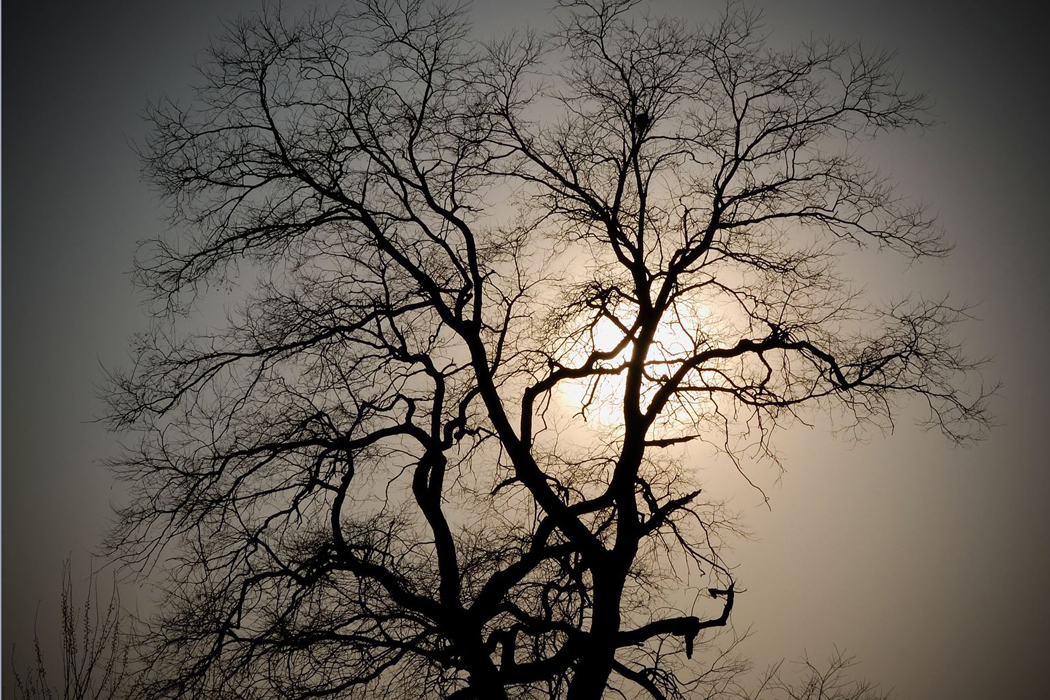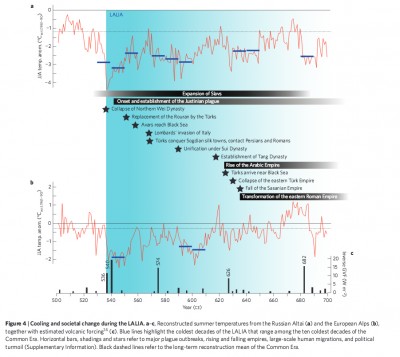New research demonstrates the widespread impact of the climatic shocks in the 6th century, creating a Late Antique Little Ice Age reaching across most of the northern hemisphere
Cooling and societal change during the Late Antique Little Ice Age from AD 536 to around 660
By Ulf Büntgen, Vladimir S. Myglan, Fredrik Charpentier Ljungqvist, Michael McCormick, Nicola Di Cosmo, Michael Sigl, Johann Jungclaus, Sebastian Wagner, Paul J. Krusic, Jan Esper, Jed O. Kaplan, Michiel A. C. de Vaan, Jürg Luterbacher, Lukas Wacker, Willy Tegel and Alexander V. Kirdyanov
In: Nature Geoscience 2016, Online 08.02.2016. DOI: 10.1038/NGEO2652
ABSTRACT:
This article presents a new series of tree-ring width samples from 152 living and 508 relict larch specimens collected at five high-elevation sites in the Russian Altai-Sayan mountains distributed between 359 BC and AD 2011. The new series complements other series with a precise climate reconstruction in the area where large-scale steppe pastoralists’ migrations are believed to have been sourced. It also presents information necessary to understand the migration of the plague bacterium, Yersinia Pestis, believed to stem from natural infection foci in Asia. Although separated by more than 7.600 km, the new Asian series corresponds remarkably to the dendroclimatological findings from the Austrian Alps
The new series of tree-ring width demonstrates the sudden and prolonged cooling off, which took place in Europa and Asia at the beginning of the 6th century and continued to characterize the period until around AD 660. More precisely, the new series demonstrate the marked cooling, which has resulted in climatologists terming the period the Late Antique Little Ice Age or LALIA (AD 536 – 660). This cooling fits well with the hypothesis that a thermal shock followed the cluster of volcanic eruptions in AD 536, 540 and 547.
In a remarkable analysis, the group of scientists demonstrates how these climatic events can be linked to the onset of the Justinian plague, a driver of crop failure and famines, and the reduced size of the Eastern Roman Empire. It is conceivable that there were significant upheavals taking place in Central Asia as early as c. 550 and continuing into the period AD 560 – 80 when the Avars arrived north of the Black Sea and made their presence felt both diplomatically as well as military. In the same period, the Proto-Slavic dialects spread across continental Europe, indicating a demographic push and sending the Lombards towards Italy (which was invaded in AD 568). It is also hypothesized that the cooling helped the growth of scrub vegetation in the Arabic Peninsula, furthering larger camel herds, thus assisting in the transportation of Arab (Muslim) armies.
Obviously, the authors are careful in their conclusions. They write that “any hypothesis of a causal nexus between the volcanic-induced sixth-century unprecedented thermal shock and subsequent plague outbreaks, rising and falling empires, human migrations, and political upheaval requires caution”. Nevertheless, it seems essential to bring into the equation climatic events when trying to grasp the long-distance population movements, which arguably did take place in the 6th century.
“We thus identify the interval from 536 to about 660 AD as the Late Antique Little Ice Age. Spanning most of the Northern Hemisphere, we suggest that this cold phase be considered as an additional environmental factor contributing to the spread of the Justinian plague, the transformation of the eastern Roman Empire and the collapse of the Sasanian Empire, movements out of the Asian steppe and Arabian Peninsula, the spread of Slavic-speaking peoples, and political upheavals in China.”
Though this is not covered by the article, the demographic and cultural shifts in Scandinavia, which are usually linked to these climatic events as well, might be added.
READ MORE:
The article is the result of a collaboration between humanists and scientists, the Initiative for the Science of the Human Past at Harvard.
PHOTO:
Oak Tree in Winter. © Anton Malikov/Image ID : 5320368. Source: 123RF.com
READ ALSO:




